History of fishing

Fishingis aprehistoricpractice dating back at least 70,000 years. Since the 16th century,fishing vesselshave been able to cross oceans in pursuit of fish, and since the 19th century it has been possible to use larger vessels and in some casesprocess the fish on board.Fish are normallycaught in the wild.Techniques for catching fishincludehand gathering,spearing,netting,anglingandtrapping.
The term fishing may be applied to catching otheraquatic animalssuch asshellfish,cephalopods,crustaceansandechinoderms.The term is not usually applied to catchingaquatic mammals,such aswhales,where the termwhalingis more appropriate, or tofarmed fish.In addition to providing food, modern fishing is alsorecreational sport.
According toFAOstatistics, the total number offishermenandfish farmersis estimated to be 38 million.Fisheriesandaquacultureprovide direct and indirect employment to over 500 million people.[1]In 2005, the worldwide per capita consumption of fish captured from wild fisheries was 14.4 kilograms, with an additional 7.4 kilograms harvested from fish farms.[2]
Prehistory[edit]
-
Hook and sinker from theLate Epipalaeolithic[3]
Fishing is an ancient practice that dates back at least to theUpper Paleolithicperiod which began about 40,000 years ago.[4][5]Isotopic analysis of the skeletal remains ofTianyuan man,a 40,000-year-old modern human from eastern Asia, has shown that he regularly consumed freshwater fish.[6][7]Archaeological features such asshell middens,[8]discarded fish bones andcave paintingsshow that sea foods were important for survival and consumed in significant quantities. During this period, most people lived a hunter-gatherer lifestyle and were, out of necessity, constantly on the move. However, where there are early examples of permanent settlements (though not necessarily permanently occupied) such as those atLepenski Vir,they are almost always associated with fishing as a major source of food.
Spearfishing with barbed poles (harpoons) was widespread in palaeolithic times.[9]Cosquer cavein Southern France contains cave art over 16,000 years old, including drawings of seals which appear to have been harpooned.
TheNeolithicculture and technology spread worldwide between 4,000 and 8,000 years ago. With the new technologies of farming and pottery came basic forms of the main fishing methods that are still used today.
From 7500 to 3000 years ago,Native Americansof the California coast were known to engage in fishing with gorge hook and line tackle.[10]In addition, some tribes are known to have used plant toxins to inducetorporin stream fish to enable their capture.[11]
Copper harpoons were known to the seafaringHarappans[12]well into antiquity.[13]Early hunters in India include the Mincopie people, aboriginal inhabitants of India'sAndaman and Nicobarislands, who have used harpoons with long cords for fishing since early times.[14]
Early history[edit]


The ancient riverNilewas full of fish; fresh and dried fish were a staple food for much of the population.[15]TheEgyptiansinvented various implements and methods for fishing and these are clearly illustrated in tomb scenes, drawings, and papyrus documents. Simplereed boatsserved for fishing. Woven nets, weir baskets made from willow branches, harpoons and hook and line (the hooks having a length of between eight millimetres and eighteen centimetres) were all being used. By the12th dynasty,metal hooks with barbs were being used. As is fairly common today, the fish were clubbed to death after capture.Nile perch,catfishandeelswere among the most important fish. Some representations hint at fishing being pursued as a pastime.
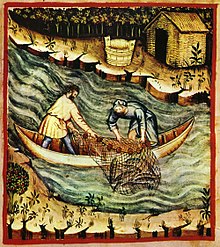
There are numerous references to fishing in ancient literature; in most cases, however, the descriptions of nets and fishing-gear do not go into detail, and the equipment is described in general terms. An early example from theBibleinJob41:7:Canst thou fill his skin with barbed irons? or his head with fish spears?
Unlike inMinoanculture,[16]fishing scenes are rarely represented inancient Greekculture, a reflection of the low social status of fishing.[citation needed]There is awine cup,dating from c. 500 BC, that shows a boy crouched on a rock with a fishing-rod in his right hand and a basket in his left. In the water below there is a rounded object of the same material with an opening on the top. This has been identified as a fish-cage used for keeping live fish, or as a fish-trap. It is clearly not a net. This object is currently in the Museum of Fine Arts, Boston.[17]
Oppian of Corycus,a Greek author wrote a major treatise on sea fishing, theHalieulicaorHalieutika,composed between 177 and 180. This is the earliest such work to have survived intact to the modern day. Oppian describes various means of fishing including the use of nets cast from boats, scoop nets held open by a hoop, spears and tridents, and various traps "which work while their masters sleep". Oppian's description of fishing with a "motionless" net is also very interesting:
- The fishers set up very light nets of buoyant flax and wheel in a circle round about while they violently strike the surface of the sea with their oars and make a din with sweeping blow of poles. At the flashing of the swift oars and the noise the fish bound in terror and rush into the bosom of the net which stands at rest, thinking it to be a shelter: foolish fishes which, frightened by a noise, enter the gates of doom. Then the fishers on either side hasten with the ropes to draw the net ashore.
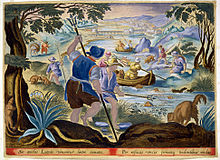
The Greek historianPolybius(ca203 BC–120 BC), in hisHistories,describes hunting for swordfish by using a harpoon with a barbed and detachable head.[18]
Pictorial evidence ofRoman fishingcomes frommosaicswhich show fishing from boats with rod and line as well as nets. Various species such asconger,lobster,sea urchin,octopusandcuttlefishare illustrated.[19]In a parody of fishing, a type ofgladiatorcalledretiariuswas armed with atridentand acasting-net.He would fight against themurmillo,who carried a short sword and a helmet with the image of a fish on the front.
The Greco-Roman sea godNeptuneis depicted as wielding a fishing trident.

In India, thePandyas,a classicalDravidianTamilkingdom, were known for the pearl fishery as early as the 1st century BC. Their seaportTuticorinwas known for deep seapearl fishing.Theparavas,a Tamil caste centred in Tuticorin, developed a rich community because of their pearl trade, navigation knowledge and fisheries.
InNorse mythologythe sea giantessRánuses a fishing net to trap lost sailors.
TheMochepeople of ancientPerudepicted fisherman in their ceramics.[20]
From ancient representations and literature it is clear that fishing boats were typically small, lacking a mast or sail, and were only used close to the shore.
In traditional Chinese history, history begins with three semi-mystical and legendary individuals who taught the Chinese the arts of civilization around 2800–2600 BC: of theseFuxiwas reputed to be the inventor of writing, hunting, trapping, and fishing.
-
Poseidon/Neptune sculpture in Copenhagen Port.
-
Relief of fishermen collecting their catch fromMereruka'stomb,6th dynasty
-
Moche fisherman. 300 A.D.Larco Museum CollectionLima, Peru.
Gillnet[edit]
Gillnetsexisted in ancient times as archaeological evidence from the Middle East demonstrates.[21]In North America, aboriginal fishermen used cedar canoes and natural fibre nets, e.g., made with nettels or the inner bark of cedar.[22]They would attach stones to the bottom of the nets as weights, and pieces of wood to the top, to use as floats. This allowed the net to suspend straight up and down in the water. Each net would be suspended either from shore or between two boats. Native fishers in the Pacific Northwest, Canada, and Alaska still commonly use gillnets in their fisheries forsalmonandsteelhead.
Both drift gillnets and setnets also have been widely adapted in cultures around the world. The antiquity of gillnet technology is documented by a number of sources from many countries and cultures.Japaneserecords trace fisheries exploitation, including gillnetting, for over 3,000 years. Many relevant details are available concerning the Edo period (1603–1867).[23]Fisheries in theShetlandIslands, which were settled byNorsemenduring theVikingera, share cultural and technological similarities with Norwegian fisheries, including gillnet fisheries for herring.[24]Many of the Norwegian immigrant fishermen who came to fish in the great Columbia River salmon fishery during the second half of the 19th century did so because they had experience in the gillnet fishery for cod in the waters surrounding theLofotenIslands of northernNorway.[25]Gillnets were used as part of the seasonal round bySwedishfishermen as well.[26]Welsh and English fishermen gillnetted for Atlantic salmon in the rivers ofWalesandEnglandincoracles,using hand-made nets, for at least several centuries.[27]These are but a few of the examples of historic gillnet fisheries around the world. Nowadays Gillnets are not used in modern fisheries due to the new regulations and laws put on the commercial fishing industry. The Gillnets would not only kill targeted fish but also harm other unintended inhabitants of the surrounding area, also known as bycatch.
Cod trade[edit]
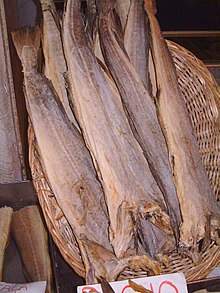
One of the world's longest lasting trade histories is thetrade of dry codfrom theLofotenarea to the southern parts ofEurope,Italy,SpainandPortugal.The trade in cod started during theVikingperiod or before, has been going on for more than 1000 years and is still important.
Cod has been an important economic commodity in aninternational marketsince theVikingperiod (around 800 AD).Norwegiansuseddried codduring their travels and soon a dried cod market developed in southernEurope.This market has lasted for more than 1000 years, passing through periods ofBlack Death,wars and other crises and still is an important Norwegian fish trade.[28]ThePortuguesehave been fishing cod in the North Atlantic since the 15th century, and clipfish is widely eaten and appreciated in Portugal. TheBasquesalso played an important role in the cod trade and are believed to have found the Canadianfishing banksin the 16th century. The North American east coast developed in part due to the vast amount of cod, and many cities in the New England area spawned near cod fishing grounds.
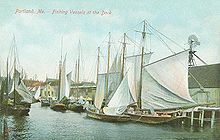
Apart from the long history this particular trade also differs from most other trade of fish by the location of the fishing grounds, far from large populations and without anydomestic market.The large cod fisheries along the coast ofNorth Norway(and in particular close to theLofotenislands) have been developed almost uniquely forexport,depending on sea transport ofstockfishover large distances.[29]Since the introduction of salt, driedsalt cod('klippfisk' in Norwegian) has also been exported. The trade operations and the sea transport were by the end of the 14th century taken over by theHanseatic League,Bergenbeing the most important port of trade.[30]
William Pitt the Elder,criticizing theTreaty of ParisinParliament,claimed that cod was "British gold"; and that it was folly to restoreNewfoundlandfishing rights to the French. In the 17th and 18th centuries, the New World, especially inMassachusettsand Newfoundland, cod became a major commodity, forming trade networks and cross-cultural exchanges.
Modern trawling[edit]
Early modern designs[edit]
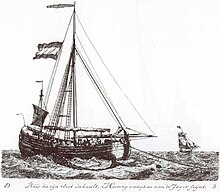
In the 15th century, the Nut developed a type of seagoingherringdrifterthat became a blueprint for European fishing boats. This was theHerring Buss,used by Dutch herring fishermen until the early 19th centuries. The ship typebusshas a long history. It was known around 1000 AD in Scandinavia as abǘza,a robust variant of the Viking longship. The first herring buss was probably built inHoornaround 1415. The last one was built inVlaardingenin 1841.
The ship was about 20 metres long and displaced between 60 and 100 tons. It was a massive round-bilgedkeelship with a bluffbowandstern,the latter relatively high, and with a gallery. The busses used long driftinggill netsto catch the herring. The nets would be retrieved at night and the crews of eighteen to thirty men[31]would set togibbing,salting and barrelling the catch on the broad deck. The ships sailed in fleets of 400 to 500 ships[31]to theDogger Bankfishing grounds and theShetlandisles. They were usually escorted by naval vessels, because the English considered they were "poaching". The fleet would stay at sea for weeks at a time. The catch would sometimes be transferred to special ships (calledventjagers), and taken home while the fleet would still be at sea (the picture shows aventjagerin the distance).[31]
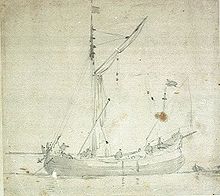
During the 17th century, the British developed thedogger,an early type of sailingtrawlerorlongliner,which commonly operated in theNorth Sea.The dogger takes its name from theDutch worddogger,meaning a fishing vessel which tows atrawl.Dutch trawling boats were common in the North Sea, and the worddoggerwas given to the area where they often fished, which became known as theDogger Bank.[32]
Doggers were slow but sturdy, capable of fishing in the rough conditions of the North Sea.[33]Like the herring buss, they were wide-beamed and bluff-bowed, but considerably smaller, about 15 metres long, a maximum beam of 4.5 metres, a draught of 1.5 metres, and displacing about 13 tonnes. They could carry a tonne of bait, three tonnes of salt, half a tonne each of food and firewood for the crew, and return with six tonnes of fish.[33]Decked areas forward and aft probably provided accommodation, storage and a cooking area. An anchor would have allowed extended periods fishing in the same spot, in waters up to 18 metres deep. The dogger would also have carried a small open boat for maintaining lines and rowing ashore.[33]

A precursor to thedorytype was the earlyFrenchbateautype, a flat bottom boat with straight sides used as early as 1671 on theSaint Lawrence River.[34]The common coastal boat of the time was thewherryand the merging of the wherry design with the simplified flat bottom of the bateau resulted in the birth of the dory. Anecdotal evidence exists of much older precursors throughout Europe. England, France, Italy, and Belgium have small boats from medieval periods that could reasonably be construed as predecessors of the Dory.[35]
Doriesappeared inNew Englandfishing towns sometime after the early 18th century.[36]They were small, shallow-draftboats,usually about five to seven metres (15 to 22 feet) long. Lightweight and versatile, with high sides, a flat bottom and sharp bows, they were easy and cheap to build. TheBanks doriesappeared in the 1830s. They were designed to be carried onmother shipsand used for fishingcodat theGrand Banks.[36]Adapted almost directly from the low freeboard, French river bateaus, with their straight sides and removable thwarts, bank dories could be nested inside each other and stored on the decks of fishing schooners, such as theGazela Primeiro,for their trip to the Grand Banks fishing grounds.
Modern fishing trawler[edit]

The Britishdoggerwas an early type of sailing trawler from the 17th century, but the modern fishing trawler was developed in the 19th century, at the English fishing port ofBrixham.
By the early 19th century, the fishermen at Brixham needed to expand their fishing area further than ever before due to the ongoing depletion of stocks that was occurring in theoverfishedwaters ofSouth Devon.TheBrixham trawlerthat evolved there was of a sleek build and had a tallgaff rig,which gave the vessel sufficient speed to make long-distance trips out to the fishing grounds in the ocean. They were also sufficiently robust to be able to tow large trawls in deep water. The great trawling fleet that built up at Brixham, earned the village the title of 'Mother of Deep-Sea Fisheries'.
This revolutionary design made large scale trawling in the ocean possible for the first time, resulting in a massive migration of fishermen from the ports in the South of England, to villages further north, such asScarborough,Hull,Grimsby,HarwichandYarmouth,that were points of access to the large fishing grounds in theAtlantic Ocean.
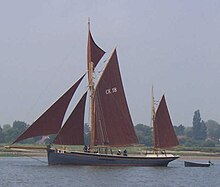
The small village ofGrimsbygrew to become the 'largest fishing port in the world'[37]by the mid 19th century. AnAct of Parliamentwas first obtained in 1796, which authorised the construction of new quays and dredging of the Haven to make it deeper.[38]It was only in the 1846, with the tremendous expansion in the fishing industry, that theGrimsby Dock Companywas formed. The foundation stone for the Royal Dock was laid byAlbertthePrince consortin 1849. The dock covered 25 acres (10 ha) and was formally opened byQueen Victoriain 1854 as the first modern fishing port. The facilities incorporated many innovations of the time - the dock gates and cranes were operated byhydraulic power,and the 300-foot (91 m)Grimsby Dock Towerwas built to provide a head of water with sufficient pressure byWilliam Armstrong.[39]The docks expanded steadily over the course of the following century: No. 2 Fish Dock opened in 1877, the Union Dock and Alexandra Dock in 1879, and No. 3 Fish Dock was built in 1934.[38]The port was served by a rail link to London'sBillingsgate Fish Market,which created a truly national market for Grimsby's fish, allowing it to become renowned nationwide.
The elegantBrixham trawlerspread across the world, influencing fishing fleets everywhere. Their distinctive sails inspired the songRed Sails in the Sunset,written aboard a Brixham sailing trawler called theTorbayLass.[40][41]By the end of the 19th century, there were over 3,000 fishing trawlers in commission in Britain, with almost 1,000 at Grimsby. These trawlers were sold to fishermen around Europe, including fromHollandandScandinavia.Twelve trawlers went on to form the nucleus of the German fishing fleet.[42]
Although fishing vessel designed increasingly began to converge around the world, local conditions still often led the development of different types of fishing boats. TheLancashire nobbywas used down the north west coast of England as a shrimp trawler from 1840 until World War II. TheManx nobbywas used around theIsle of Manas a herring drifter. Thefifiewas also used as a herring drifter along the east coast of Scotland from the 1850s until well into the 20th century.
The bawley and thesmackwere used in the Thames Estuary and offEast Anglia,while trawlers and drifters were used on the east coast. Herring fishing started in theMoray Firthin 1819. The peak of the fishing atAberdeenwas in 1937 with 277 steam trawlers, though the first diesel drifter was introduced in 1926. In 1870 paddle tugs were being used to tow luggers and smacks to sea.
Advent of steam power[edit]
The earliest steam powered fishing boats first appeared in the 1870s and used thetrawlsystem of fishing as well as lines and drift nets. These were large boats, usually 80–90 feet (24–27 m) in length with a beam of around 20 feet (6.1 m). They weighed 40-50 tons and travelled at 9–11 knots (17–20 km/h; 10–13 mph).
The earliest purpose built fishing vessels were designed and made by David Allan inLeithin March 1875, when he converted a drifter to steam power. In 1877, he built the firstscrew propelledsteam trawlerin the world. This vessel wasPioneer LH854.She was of wooden construction with two masts and carried a gaff rigged main and mizen using booms, and a single foresail.Pioneeris mentioned inThe Shetland Timesof 4 May 1877. In 1878 he completedForwardandOnward,steam-powered trawlers for sale. Allan argued that his motivation for steam power was to increase the safety of fishermen. However local fishermen saw power trawling as a threat. Allan built a total of ten boats atLeithbetween 1877 and 1881. Twenty-one boats were completed atGranton,his last vessel beingDegravein 1886. Most of these were sold to foreign owners inFrance,Belgium,Spainand theWest Indies.[43]
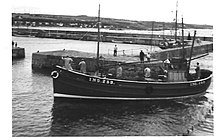
The firststeam boatswere made of wood, butsteelhullswere soon introduced and were divided intowatertightcompartments. They were well designed for the crew with a large building that contained thewheelhouseand thedeckhouse.The boats built in the 20th century only had amizzensail,which was used to help steady the boat when its nets were out. The main function of the mast was now as acranefor lifting the catch ashore. It also had a steamcapstanon theforedecknear the mast for haulingnets.The boats had narrow, highfunnelsso that the steam and thick coal smoke was released high above the deck and away from the fishermen. These funnels were nicknamedwoodbinesbecause they looked like the popular brand of cigarette. These boats had a crew of twelve made up of askipper,driver, fireman (to look after the boiler) and nine deck hands.[43]
Steam fishing boats had many advantages. They were usually about 20 ft longer (6.1 m) than the sailing vessels so they could carry more nets and catch more fish. This was important, as the market was growing quickly at the beginning of the 20th century. They could travel faster and further and with greater freedom fromweather,wind andtide.Because less time was spent travelling to and from the fishing grounds, more time could be spent fishing. The steam boats also gained the highest prices for their fish, as they could return quickly to harbour with their fresh catch. The main disadvantage of the steam boats, though, was their high operating costs. Their engines were mechanically inefficient and took up much space, while fuel and fitting out costs were very high. Before theFirst World War,building costs were between £3,000 and £4,000, at least three times the cost of the sail boats. To cover these high costs, they needed to fish for longer seasons. The higher expenses meant that more steam drifters were company-owned or jointly owned. As the herring fishing industry declined, steam boats became too expensive.[43]
Steam trawlers were introduced atGrimsbyandHullin the 1880s. In 1890 it was estimated that there were 20,000 men on the North Sea. The steam drifter was not used in the herring fishery until 1897. The last sailing fishing trawler was built in 1925 in Grimsby.
Further development[edit]

Trawler designs adapted as the way they were powered changed from sail to coal-fired steam byWorld War Itodieselandturbinesby the end ofWorld War II.
During both World Wars, many fishing trawlers were commissioned asnaval trawlers.Fishing trawlers were particularly suited for many naval requirements because they were robust boats designed to work heavytrawlsin all types of weather and had large clear working decks. One could create amine sweepersimply by replacing the trawl with a mine sweep. Addingdepth chargeracks on the deck,ASDICbelow, and a 3-inch (76 mm) or 4-inch (102 mm) gun in the bows equipped the trawler foranti-submarineduties.
TheRoyal Navyordered many naval trawlers toAdmiraltyspecifications. Shipyards such asSmiths Dock Companythat were used to building fishing trawlers could easily switch to constructing naval versions. As a bonus, the Admiralty could sell these trawlers to commercial fishing interests when the wars ended. Still, many were sunk during the war, such asHMTAmethystandHMTForce.
Armed trawlers were also used to defend fishing groups from enemy aircraft or submarines. The smallest civilian trawlers were converted todanlayers.
In 1931, the first powered drum was created by Laurie Jarelainen. The drum was a circular device that was set to the side of the boat and would draw in the nets. The powered drum allowed the nets to be drawn in much faster, so fishermen were able to fish in areas they had previously been unable to go into, thereby revolutionizing the fishing industry.

DuringWorld War II,navigationand communication devices, as well as many other forms of maritime equipment (depth-soundingandradar) were improved and made more compact. These devices became much more accessible to the average fisherman, thus making their range and mobility larger. It also served to make the industry much more competitive, as the fisherman were forced to invest more into their boats, equipped with electronic aids, such asradio navigation aidsandfish finders.During theCold War,some countries fitted fishing trawlers with additional electronic gear so they could be used asspy shipsto monitor the activities of other countries.
The first trawlers fished over the side, rather than over thestern.In 1947, the companyChristian Salvesen,based inLeith,Scotland, refitted a surplusAlgerine-class minesweeper(HMSFelicity) with refrigeration equipment and a factory ship stern ramp, to produce the first combined freezer/stern trawler.[44]
The first purpose built stern trawler wasFairtrybuilt in 1953 atAberdeen.The ship was much larger than any other trawlers then in operation and inaugurated the era of the 'super trawler'. As the ship pulled its nets over the stern, it could lift out a much greater haul of up to 60 tons.Lord Nelsonfollowed in 1961, installed with vertical plate freezers that had been researched and built at theTorry Research Station.These ships served as a basis for the expansion of 'super trawlers' around the world in the following decades.[44]
The introduction of finesynthetic fibressuch asnylonin the construction of fishing gear during the 1960s marked an expansion in the commercial use of gillnets. The new materials were cheaper and easier to handle, lasted longer and required less maintenance thannatural fibres.In addition, fibres such as nylon monofilaments become almost invisible in water, so nets made with synthetic twines generally caught greater numbers of fish than natural fibre nets used in comparable situations. Due to environmental concerns,gillnetswere banned by theUnited Nationsin 1993 in international waters, although their use is still permitted within 200 nautical miles (400 km) of a coast.
Recreational fishing[edit]
The early evolution of fishing as recreation is not clear. For example, there is anecdotal evidence forfly fishingin Japan as early as the ninth century BC,[45]and in EuropeClaudius Aelianus(175–235 AD) describes fly fishing in his workOn the Nature of Animals.[46]
But for the early Japanese andMacedonians,fly fishing was likely to have been a means of survival, rather than recreation. It is possible that antecedents of recreational fly fishing arrived in England with theNorman conquestof 1066.[46]Although the point in history where fishing could first be said to be recreational is not clear,[47]it is clear that recreational fishing had fully arrived with the publication ofThe Compleat Angler.
Origins[edit]

The earliest English essay on recreational fishing was published in 1496, shortly after the invention of the printing press. The authorship of this was attributed toDame Juliana Berners,the prioress of the BenedictineSopwell Nunnery.The essay was titledTreatyse of Fysshynge wyth an Angle,[48]and was published in the secondBoke of Saint Albans,a treatise on hawking, hunting, and heraldry. These were major interests of the nobility, and the publisher,Wynkyn de Worde,was concerned that the book should be kept from those who were not gentlemen, since their immoderation in angling might "utterly destroy it".[49]
During the 16th century the work was much read, and was reprinted many times.Treatyseincludes detailed information on fishing waters, the construction of rods and lines, and the use of natural baits and artificial flies. It also includes modern concerns about conservation and angler etiquette.[50]
The earliest English poetical treatise on Angling byJohn Dennys,said to have been a fishing companion of Shakespeare, was published in 1613,The Secrets of Angling.Footnotes of the work, written by Dennys' editor, William Lawson, make the first mention of the phrase to 'cast a fly': "The trout gives the most gentlemanly and readiest sport of all, if you fish with an artificial fly, a line twice your rod's length of three hairs' thickness... and if you have learnt the cast of the fly."[51]

Woodcut byLouis Rhead
The art of fly fishing took a great leap forward after theEnglish Civil War,where a newly found interest in the activity left its mark on the many books and treatises that were written on the subject at the time. The renowned officer in theParliamentary army,Robert Venables,published in 1662The Experienced Angler, or Angling improved, being a general discourse of angling, imparting many of the aptest ways and choicest experiments for the taking of most sorts of fish in pond or river.Another Civil War veteran to enthusiastically take up fishing, wasRichard Franck.He was the first to describe salmon fishing in Scotland, and both in that and trout-fishing withartificial flyhe was a practical angler. He was the first angler to name theburbot,and commended the salmon of theRiver Thames. [52]
Compleat Anglerwas written byIzaak Waltonin 1653 (although Walton continued to add to it for a quarter of a century) and described the fishing in theDerbyshireWye.It was a celebration of the art and spirit of fishing in prose and verse; 6 verses were quoted fromJohn Dennys's earlier work. A second part to the book was added by Walton's friendCharles Cotton.[52]
Walton did not profess to be an expert with a fishing fly; the fly fishing in his first edition was contributed by Thomas Barker, a retired cook andhumorist,who produced atreatiseof his own in 1659; but in the use of the liveworm,thegrasshopperand thefrog"Piscator" himself could speak as a master. The famous passage about the frog, often misquoted as being about the worm— "use him as though you loved him, that is, harm him as little as you may possibly, that he may live the longer" —appears in the original edition. Cotton's additions completed the instruction in fly fishing and advised on the making ofartificial flieswhere he listed sixty five varieties.
Charles Kirby designed an improved fishing hook in 1655 that remains relatively unchanged to this day. He went on to invent the Kirby bend, a distinctive hook with an offset point, still commonly used today.[53]
Development[edit]

The 18th century was mainly an era of consolidation of the techniques developed in the previous century. Running rings began to appear along the fishing rods, which gave anglers greater control over the cast line. The rods themselves were also becoming increasingly sophisticated and specialized for different roles. Jointed rods became common from the middle of the century andbamboocame to be used for the top section of the rod, giving it a much greater strength and flexibility.
The industry also became commercialized - rods and tackle were sold at thehaberdashersstore. After theGreat Fire of Londonin 1666, artisans moved toRedditchwhich became a centre of production of fishing related products from the 1730s.Onesimus Ustonsonestablished his trading shop in 1761, and his establishment remained as a market leader for the next century. He received aRoyal Warrantfrom three successive monarchs starting with KingGeorge IV.[54]
Some have credited Onesimus with the invention of themultiplying winch,although he was certainly the first to advertise its sale. Early multiplying reels were wide and had a small diameter, and their gears, made ofbrass,often wore down after extensive use. His earliest advertisement in the form of a trading card date from 1768 and was entitledTo all lovers of angling.A full list of the tackles he sold included artificial flies, and 'the best sort of multiplying brass winches both stop and plain'. The commercialization of the industry came at a time of expanded interest in fishing as a recreational hobby for members of thearistocracy.[55]
The impact of theIndustrial Revolutionwas first felt in the manufacture of fly lines. Instead of anglers twisting their own lines - a laborious and time-consuming process - the newtextilespinning machines allowed for a variety of tapered lines to be easily manufactured and marketed.
British fly-fishing continued to develop in the 19th Century, with the emergence of fly fishing clubs, along with the appearance of several books on the subject of fly tying and fly fishing techniques.

Alfred Ronaldstook up the sport of fly fishing, learning the craft on the riversTrent,BlytheandDove.On the River Blythe, near what is todayCreswell Green,Ronalds constructed a bankside fishing hut designed primarily as an observatory of trout behaviour in the river. From this hut, and elsewhere on his home rivers, Ronalds conducted experiments and formulated the ideas that eventually were published inThe Fly-fisher's Entomologyin 1836.[56]
He combined his knowledge of fly fishing with his skill as an engraver and printer, to lavish his work with 20 colour plates. It was the first comprehensive work related to theentomologyassociated with fly fishing and most fly-fishing historians credit Ronalds with setting a literature standard in 1836 that is still followed today.[57]Describing methods, techniques and, most importantly,artificial flies,in a meaningful way for the angler and illustrating them in colour is a method of presentation that can be seen in most fly-fishing literature today.
The book was mostly about the aquatic insects—mayflies,caddisfliesandstoneflies—thattroutandgraylingfeed on and their counterpart artificial imitations. About half the book is devoted to observations of trout, their behaviour, and the methods and techniques used to catch them. Most of this information, although enhanced by Ronalds' experiences and observations, was merely an enhancement of Charles Bowlker'sArt of Angling(first published in 1774 but still in print in 1836).[58]
In Chapter IV -Of a Selection of Insects, and Their Imitations, Used in Fly Fishing- for the first time is discussed specific artificial fly imitations by name, associated with the corresponding natural insect. Organized by their month of appearance, Ronalds was the first author to begin the standardization of angler names for artificial flies. Prior toThe Fly-fisher's Entomology,anglers had been given suggestions for artificial flies to be used on a particular river or at a particular time of the year, but those suggestions were never matched to specific natural insects the angler might encounter on the water.[59]According toErnest Schwiebert:"Ronalds is one of the major milestones in the entire literature of fly-fishing, and with hisEntomologythe scientific method has reached angling in full flower. Ronalds was completely original in its content and research, setting the yardstick for all subsequent discussion and illustration of aquatic fly hatches.[60]
Technological improvements[edit]

Modern reel design had begun in England during the later part of the 18th century, and the predominant model in use was known as the 'Nottinghamreel'. The reel was a wide drum which spooled out freely, and was ideal for allowing the bait to drift along way out with the current. Geared multiplying reels never successfully caught on in Britain, but had more success in the United States, where similar models were modified byGeorge SnyderofKentuckyinto his bait-casting reel, the first American-made design in 1810.[61]
The material used for the rod itself changed from the heavy woods native to England, to lighter and more elastic varieties imported from abroad, especially fromSouth Americaand theWest Indies.Bamboorods became the generally favoured option from the mid 19th century, and several strips of the material were cut from the cane, milled into shape, and then glued together to form light, strong, hexagonal rods with a solid core that were superior to anything that preceded them.George Cottonand his predecessors fished their flies with long rods, and light lines allowing the wind to do most of the work of getting the fly to the fish. [62]
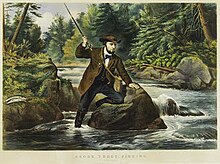
Tackle design began to improve from the 1880s. The introduction of new woods to the manufacture of fly rods made it possible to cast flies into the wind onsilklines, instead ofhorse hair.These lines allowed for a much greater casting distance. However, these early fly lines proved troublesome as they had to be coated with various dressings to make them float and needed to be taken off the reel and dried every four hours or so to prevent them from becoming waterlogged. Another negative consequence was that it became easy for the much longer line to get into a tangle - this was called a 'tangle' in Britain, and a 'backlash' in the US. This problem spurred the invention of the regulator to evenly spool the line out and prevent tangling.[62]
The American, Charles F. Orvis, designed and distributed a novel reel and fly design in 1874, described by reel historian Jim Brown as the "benchmark of American reel design," and the first fully modern fly reel.[63][64]The founding of The Orvis Company helped institutionalize fly fishing by supplying angling equipment via the circulation of his tackle catalogs, distributed to a small but devoted customer list.[citation needed]
Albert Illingworth, 1st Baron Illingwortha textiles magnate, patented the modern form of fixed-spool spinning reel in 1905. When casting Illingworth's reel design, the line was drawn off the leading edge of the spool, but was restrained and rewound by a line pickup, a device which orbits around the stationary spool. Because the line did not have to pull against a rotating spool, much lighter lures could be cast than with conventional reels.[62]
Expansion[edit]

By the mid to late 19th century, expandingleisureopportunities for the middle and lower classes began to have its effect on fly fishing, which steadily grew in mass appeal. The expansion of therailwaynetwork in Britain allowed the less affluent for the first time to take weekend trips to theseasideor to rivers for fishing. Richerhobbyistsventured further abroad.[65]The large rivers ofNorwayreplete with large stocks ofsalmonbegan to attract fishers from England in large numbers in the middle of the century -Jones's guide to Norway, and salmon-fisher's pocket companion,published in 1848, was written by Frederic Tolfrey and was a popular guide to the country.[65]
In southern England, dry-fly fishing acquired an elitist reputation as the only acceptable method of fishing the slower, clearer rivers of the south such as theRiver Testand the other chalk streams concentrated inHampshire,Surrey,DorsetandBerkshire(seeSouthern England Chalk Formationfor the geological specifics). The weeds found in these rivers tend to grow very close to the surface, and it was felt necessary to develop new techniques that would keep the fly and the line on the surface of the stream. These became the foundation of all later dry-fly developments.
However, there was nothing to prevent the successful employment of wet flies on these chalk streams, asG. E. M. Skuesproved with his nymph and wet fly techniques. To the horror of dry-fly purists, Skues later wrote two books,Minor Tactics of the Chalk Stream,andThe Way of a Trout with a Fly,which greatly influenced the development of wet fly fishing. In northern England and Scotland, many anglers also favored wet-fly fishing, where the technique was more popular and widely practiced than in southern England. One of Scotland's leading proponents of the wet fly in the early-to-mid 19th century was W. C. Stewart, who published "The Practical Angler" in 1857.

In the United States, attitudes toward methods of fly fishing were not nearly as rigidly defined, and both dry- and wet-fly fishing were soon adapted to the conditions of the country. Fly anglers there, are thought to be the first anglers to have used artificial lures forbass fishing.After pressing into service the fly patterns and tackle designed for trout and salmon to catch largemouth and smallmouth bass, they began to adapt these patterns into specific bass flies. Fly anglers seeking bass developed the spinner/fly lure and bass popper fly, which are still used today.[66]
In the late 19th century, American anglers, such asTheodore Gordon,in theCatskill MountainsofNew Yorkbegan using fly tackle to fish the region'sbrook trout-rich streams such as the Beaverkill and Willowemoc Creek. Many of these early American fly anglers also developed new fly patterns and wrote extensively about their sport, increasing the popularity of fly fishing in the region and in the United States as a whole.[66]Albert Bigelow Paine,aNew Englandauthor, wrote about fly fishing inThe Tent Dwellers,a book about a three-week trip he and a friend took to centralNova Scotiain 1908.
Participation in fly fishing peaked in the early 1920s in the eastern states ofMaineandVermontand in the Midwest in the spring creeks ofWisconsin.Along withdeep sea fishing,Ernest Hemingwaydid much to popularize fly fishing through his works of fiction, includingThe Sun Also Rises.
Fly fishing inAustraliatook off whenbrown troutwere first introduced by the efforts of Edward Wilson's Acclimatisation Society of Victoria with the aim to "provide for manly sport which will lead Australian youth to seek recreation on the river's bank and mountainside rather than in the Cafe and Casino.[67]"The first successful transfer of Brown Trout ova (from the Itchen and Wye) was accomplished byJames Arndell Youl,with a consignment aboardThe Norfolkin 1864. Rainbow Trout were not introduced until 1894.
It was the development of inexpensive fiberglass rods, synthetic fly lines, and monofilament leaders, however, in the early 1950s, that revived the popularity of fly fishing. In recent years, interest in fly fishing has surged asbaby boomershave discovered the sport. Movies such asRobert Redford's filmA River Runs Through It,starringCraig ShefferandBrad Pitt,cable fishing shows, and the emergence of a competitive fly casting circuit have added to the sport's visibility.
Fishing in art[edit]
-
Engraving of Russian peasant children fishing, A.P. Koverznev 1875
-
Fishing,Almeida Júnior1894
-
Fishing from a canoe,Albert Bierstadt(1830–1902)
-
Fishing with a harpoon,Adolph TidemandandHans Gude1851
-
The fishing fleet atReine,Gunnar Berg(1863–93)
-
The Chinese fishing nets of Fort Cochin, "from 'Das Buch der Welt', Stuttgart, 1842–48
See also[edit]
Notes[edit]
- ^Fisheries and Aquaculture in our Changing ClimatePolicy brief of theFAOfor theUNFCCCCOP-15in Copenhagen, December 2009.
- ^FAO: Fisheries and Aquaculture
- ^Pedergnana, Antonella; Cristiani, Emanuela; Munro, Natalie; Valletta, Francesco; Sharon, Gonen (6 October 2021)."Early line and hook fishing at the Epipaleolithic site of Jordan River Dureijat (Northern Israel)".PLOS ONE.16(10). Public Library of Science (PLoS): e0257710.doi:10.1371/journal.pone.0257710.ISSN1932-6203.PMC8494375.PMID34613991.
- ^African Bone Tools Dispute Key Idea About Human EvolutionNational Geographic News article.
- ^Early humans followed the coastBBC News article.
- ^Yaowu Hu Y, Hong Shang H, Haowen Tong H, Olaf Nehlich O, Wu Liu W, Zhao C, Yu J, Wang C, Trinkaus E and Richards M (2009)"Stable isotope dietary analysis of the Tianyuan 1 early modern human"Proceedings of the National Academy of Sciences,106(27) 10971-10974.
- ^First direct evidence of substantial fish consumption by early modern humans in ChinaPhysOrg.com,6 July 2009.
- ^Coastal Shell Middens and Agricultural Origasims in Atlantic Europe.
- ^Guthrie, Dale Guthrie (2005)The Nature of Paleolithic Art.Page 298. University of Chicago Press.ISBN0-226-31126-0
- ^King 1991, pp. 80-81.
- ^Rostlund 1952, pp. 188-190
- ^Ray 2003, page 93
- ^Allchin 1975, page 106
- ^Edgerton 2003, page 74
- ^"Fisheries history: Gift of the Nile"(PDF).Archived fromthe original(PDF)on 2006-11-10..
- ^The Minoan Culture,historywiz.com Accessed 2015-12-28
- ^Image of an ancient angler on a wine cup.
- ^Polybius,"Fishing for Swordfish",HistoriesBook 34.3 (Evelyn S. Shuckburgh,translator). London, New York: Macmillan, 1889. Reprint Bloomington, 1962.
- ^Image of fishing illustrated in a Roman mosaicArchived2011-07-17 at theWayback Machine.
- ^Berrin, Katherine & Larco Museum.The Spirit of Ancient Peru:Treasures from theMuseo Arqueológico Rafael Larco Herrera.New York:Thames and Hudson,1997.
- ^Nun, Mendel (1989).The Sea of Galilee and Its Fishermen in the New Testament,pp. 28-44. Kibbutz Ein Gev, Kinnereth Sailing Co.
- ^Stewart, Hilary (1994).Indian Fishing: Early Methods on the Northwest Coast.Seattle, University of Washington Press.
- ^Ruddle, Kenneth and Akimich, Tomoya. “Sea Tenure in Japan and the Southwestern Ryukyus,” in Cordell, John, Ed. (1989),A Sea of Small Boats,pp. 337-370. Cambridge, Mass., Cultural Survival, Inc.
- ^Goodlad, C.A. (1970).Shetland Fishing Saga,pp. 59-60. The Shetland Times, Ltd.
- ^Martin, Irene (1994).Legacy and Testament: The Story of the Columbia River Gillnetter,p. 38. Pullman, Washington State University Press.
- ^Lofgen, Ovar. “Marine Ecotypes in Preindustrial Sweden: A Comparative Discussion of Swedish Peasant Fishermen,” in Andersen, Raoul, ed.,North Atlantic Maritime Cultures,pp. 83-109. The Hague, Mouton.
- ^Jenkins, J. Geraint (1974).Nets and Coracles,p. 68. London, David and Charles.
- ^James Barrett; Roelf Beukens; Ian Simpson; Patrick Ashmore; Sandra Poaps; Jacqui Huntley (2000). "What Was the Viking Age and When did it Happen? A View from Orkney".Norwegian Archaeological Review.33(1).
- ^G. Rollefsen (1966)."Norwegian fisheries research".Fiskeridirektoratets Skrifter, Serie Havundersøkelser.14(1): 1–36.
- ^A. Holt-Jensen (1985). "Norway and sea the shifting importance of marine resources through Norwegian history".GeoJournal.10(4): 393–399.doi:10.1007/BF00461710.S2CID153579866.
- ^abcDe Vries & Woude (1977), pages 244–245
- ^Oxford Companion to Ships and the Sea, p. 256
- ^abcFagan 2008
- ^Gardner 1987, page 18
- ^Gardner 1987, page 15
- ^abChapelle, page 85
- ^Days out: “Gone fishing in Grimsby”[permanent dead link]The Independent,8 September 2002
- ^ab"A brief history of Grimsby".localhistories.org.
- ^"Great Grimsby".UK Genealogy Archives.
- ^"History of a Brixham trawler".JKappeal.org. 2 March 2009. Archived fromthe originalon 2 December 2010.Retrieved13 September2010.
- ^"Pilgrim's restoration under full sail".BBC.Retrieved2 March2009.
- ^Sailing trawlers.
- ^abc"The Steam Trawler".
- ^ab"HISTORY".Archived fromthe originalon 2013-08-21.Retrieved2015-07-05.
- ^Herd, Andrew (2003)The Fly.Medlar Press.ISBN978-1-899600-29-8
- ^ab"A Macedonian way of catching fish... They fasten red (crimson red) wool round a hook, and fix on to the wool two feathers which grow under a cock’s wattles, and which in colour are like wax. Their rod is six feet long, and their line is the same length. Then they throw their snare, and the fish, attracted and maddened by the colour, comes straight at it..." McCully, CB (2000)The Language of Fly-FishingTaylor & Francis, pp. 76_78.ISBN978-1-57958-275-3.
- ^Schullery, PaulFly fishing History: Beginnings: Aelian LivesArchived2013-01-28 atarchive.today
- ^Berners, Dame Juliana (1496)A treatyse of fysshynge wyth an Angle(transcription by Risa S. Bear).
- ^Cowx, I G (2002) Handbook of Fish Biology and Fisheries,Chapter 17: Recreational fishing.Blackwell Publishing.ISBN0-632-06482-X
- ^Berners, Dame Juliana. (2008). In Encyclopædia Britannica. Retrieved June 20, 2008, fromEncyclopædia Britannica Online
- ^C. B. McCully (2000).The Language of Fly-Fishing.Taylor & Francis. p. 41.
- ^abAndrew N. Herd."Fly fishing techniques in the fifteenth century".Archived fromthe originalon 2014-06-21.Retrieved2014-07-16.
- ^Stan L. Ulanski (2003).The Science of Fly-fishing.University of Virginia Press. p. 4.
- ^"Welcome To Great Fly Fishing Tips".Archived fromthe originalon 2017-06-27.Retrieved2015-07-05.
- ^"Fishing Tackle Chapter 3"(PDF).Archived fromthe original(PDF)on 2013-09-18.Retrieved2015-07-05.
- ^Herd, Andrew Dr (2001).The Fly.Ellesmere, Shropshire: Medlar Press.ISBN1-899600-19-1.
- ^Schullery, Paul (1996).American Fly Fishing-A History.Norwalk, CT: The Easton Press. p. 85.
- ^Westwood, T.; Satchell W. (1883).Bibliotheca Piscatoria.London: W. Satchell. pp.39–40.
- ^Herd, Andrew (2010). "Alfred Ronalds—The First Angler Entomologist".Angling Giants—Anglers Who Made History.Ellesmere, UK: The Medlar Press. pp. 250–253.ISBN978-1-899600-60-1.
- ^Schwiebert, Ernest(1973).Nymphs.New York: Winchester Press. p. 8.ISBN0-87691-074-6.
- ^Andrew N. Herd."Fly Fishing in the Eighteenth Century".Archived fromthe originalon 2014-07-19.Retrieved2015-07-05.
- ^abc"fishing".Encyclopædia Britannica.
- ^Brown, Jim.A Treasury of Reels: The Fishing Reel Collection of The American Museum of Fly Fishing.Manchester, Vermont: The American Museum of Fly Fishing, 1990.
- ^Schullery, Paul.The Orvis Story: 150 Years of an American Sporting Tradition.Manchester, Vermont, The Orvis Company, Inc., 2006
- ^abAndrew N. Herd."Fly Fishing in the Years 1800 - 1850".Archived fromthe originalon 2014-07-03.Retrieved2014-07-16.
- ^abWaterman, Charles F.,Black Bass and the Fly Rod,Stackpole Books (1993)
- ^The Argusnewspaper 14 April 1864
References[edit]
- Bekker-Nielson (2002)"Fish in the ancient economy"In: Skydsgaard JE and Ascani K (Eds.)Ancient history matters: Studies presented to Jens Erik Skydsgaard on his seventieth birthday,L'erma di Bretschneider. Pages 29–38.ISBN978-88-8265-190-9
- Bekker-Nielsen, Tønnes (2005)Ancient fishing and fish processing in the Black Sea regionAarhus University Press.ISBN9788779340961.
- King, Chester D (1991).Evolution of Chumash Society: A Comparative Study of Artifacts Used for Social System Maintenance in the Santa Barbara Channel Region before A.D. 1804.New York and London, Garland Press.
- Lytle, Ephraim (2006)Marine Fisheries and the Ancient Greek Economy,ProQuest.ISBN9780542816024.
- Pieters M, Verhaeghe F, Gevaert G, Mees J and Seys J. (Ed.) (2003)Colloquium: Fishery, trade and piracy: fishermen and fishermen's settlements in and around the North Sea area in the Middle Ages and laterArchived2012-03-08 at theWayback MachineMuseum Walraversijde, VLIZ Special Publication 15.
- Rostlund, Erhard (1952).Freshwater Fish and Fishing in Native North America.University of California Publications in Geography, Volume 9. Berkeley.
- Sahrhage, Dietrich and Lundbeck, Johannes (1992)A History of Fishing.Springer.ISBN978-0-387-55332-0
- Smith, Tim D (2002). Handbook of Fish Biology and Fisheries, Chapter 4,A history of fisheries and their science.Blackwell Publishing.ISBN0-632-06482-X
- Sicking Land Abreu-Ferreira D (Eds.) (2009)Beyond the catch: fisheries of the North Atlantic, the North Sea and the Baltic, 900-1850Brill.ISBN978-90-04-16973-9.
- Starkey, David J.; Jon Th. Thor & Ingo Heidbrink (Eds.): A History of the North Atlantic Fisheries: Vol. 1, From Early Times to the mid-Nineteenth Century. Bremen (Hauschild Vlg. & Deutsches Schiffahrtsmuseum) 2009.
External links[edit]
- Roman fishing[1]
- Fish and Fishermen. Observations on fishing methods on Roman Mosaics in Greece
- Medieval Origins of Commercial Sea Fishing Project
- Fishing & Fishermen in the Middle Ages and Renaissance
- The Shoals of Herringsung byEwan MacCollwith historic images of herring fishing inGreat Yarmouth–YouTube


![Hook and sinker from the Late Epipalaeolithic[3]](https://upload.wikimedia.org/wikipedia/commons/thumb/0/06/Reconstruction_of_a_prehistoric_hook_and_sinker.png/166px-Reconstruction_of_a_prehistoric_hook_and_sinker.png)













